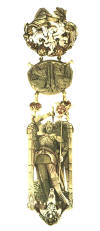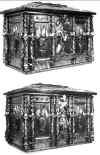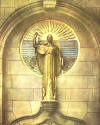Edinburgh Castle – a
Legacy
and a Memorial

St Michael, carving suspended from the roof.
Most
people of Scottish origin will have seen the towering edifice of
Edinburgh
Castle
either in
photographs, travel magazines when planning the trip to
the
ancestral
home or
on film or
television when the Edinburgh Tattoo is
taking
place.
But it is
not only a
legacy
from
turbulent
times but also the site of
the
Scottish
National
War
Memorial
The
origin of the castle goes back to
Edwin, the seventh century king of
Northumbria who probably had a
fortress
on the rock. Malcolm III of
Scotland
erected a wooden fort on
the rock in
the 11th
century
and later kings built stone walls with inner buildings. Several times the castle was held by
the
English, Edward I used a
form of the Roman ballista or
catapult to hurl rocks at
the walls and seized it in 1296. In 1313 it
was taken by
a party of
30 Scots who scaled the walls and caught the guard by
surprise. While Robert the Bruce dismantled it
only for Edward III of
England
to
rebuild
it in 1337. The castle has been the scene for many a
gruesome
event and also of
daring.
In 1440 the young Earl of
Douglas
and his brother were lured there for a
banquet
and were seized and beheaded. Some fifty years later the Duke of
Albany escaped over the battlements using a
knotted
rope – he must have been a brave man,
and probably desperate, as it
is an awful long way straight down !.
It was here that Mary Queen of
Scots
gave
birth to the future King James VI
(James the First of
England )
on 19 June 1566.
She is alleged to
have said `This is the son who shall first unite the two kingdoms of
Scotland and England ` – her wish came true in
1603. The castle was the scene for a desperate defence by
British
soldiers
when the Jacobite rebels seized Edinburgh in
1745. Within the castle walls there are today several important buildings including the Great Hall with its collection of
weapons
and
armour. The Honours
of
Scotland
as they are called – the Crown, Sceptre and Sword of
State together with the Stone of
Scone are in
the Crown Room. And, of course, there is the famous One o`clock Gun which is
fired
every day except Sunday at
precisely
1.00 pm.
With such a
history
it is little wonder that the Castle was used for military purposes until the end of
the First World War. But even before the Armistice was signed it had been decided that the castle would not be
needed
for a large body of
troops
after the
war. In July 1919 the recommendation was made that there should be
a
dedicated
shrine on the
 Castle
Castle
Rock
although
it was not until 1924 that the work got under way. A
great
deal of planning went into the project and old materials from demolished buildings were combined with the best of
Scottish
arts and crafts to
create
what is undeniably a
worthy
memorial
to some 100,000 Scots who perished in
the Great War.
Mere
words
cannot
describe
the
quality
of the workmanship that went into the structure, the sculptured stoneworks, the stained glass windows, nor a
magnificent bronze frieze. There are two essentially different parts to
the
Memorial
– the Hall of
Honour
which is
a focus
for
record
and
remembrance; and, the Shrine which is
for the more personal prayer and remembrance of
loved
ones.
Each has its own quite unique features.
 The Shrine contains the Casket, made by Thomas Hadden and donated by
The Shrine contains the Casket, made by Thomas Hadden and donated by
their Majesties King George V and Queen Mary, is set upon the bare rock tip that is
the castle foundation.
In the Casket are the Rolls of
Honour of the regiments. Overlooking all, carved in
Scottish
oak and suspended from the ceiling is
a
magnificent figure of
the
Archangel St Michael stern of
face, representing Righteousness overcoming Wrong.
The artwork and design of the Casket is magnificent
but pride of place must be the bronze frieze than runs
round the shrine. Designed by Morris and Alice
Meredith Williams, it contains some sixty
representations of the men and women of all ranks and
services who served in the Great War.
There are seven stained glass windows which together portray in
three
groups :-
the birth of
War on the west wall; the overthrow of
War in the east wall and Peace, Thanksgiving and Praise to God in
the
northerly
windows.
Around
the walls
 beneath the windows there is the
beneath the windows there is the
stunning
bronze
frieze
which
depicts
the
various
types of Scottish soldiers, sailors, airmen, nurses in
their
battle
dress as they lived and died. All Scotch regiments and services in
which
they
served are depicted, and even the animals – the
elephants, horses, dogs, canaries used in tunnelling
safety checks, and carrier pigeons have not been forgotten. Enlarged images of the frieze are
here. Frieze1
Frieze2
Frieze3.
The Hall of
Honour
also has eight beautiful stained glass windows but they are more of
the
functional kind. They are of
paler
glass and include the memorials to the Navy and Air Force, the war at
Home, as
well as the Four Seasons. The long walls of
the Hall are pillared and separated into small sanctuaries dedicated to
particular regiments. Each is
similar
yet with an
emphasis
that is
special
to those whose memory it
preserves. There are two bays where are commemorated amongst others the Padres, the Womens` Services, the Mercantile Marine, the Royal Artillery. the Royal Engineers, the Royal Army Service Corps, the Royal Army Medical Corps and the Yeomanry.
Most
symbolic
of all perhaps is
the
carved
Pelican
above the Porch piercing her breast for drops of
Porch piercing her breast for drops of
blood to feed her young, to
remind us of
the self sacrifice of
those
commemorated here. So remember too that these works were created by
Scottish craftsmen, in homage to
Scottish
sons and daughters, husbands, wives and lovers and is no less than a
Memorial
to
Scotland
itself.
When you go
home, tell them of
us and say
`For your tomorrows these gave their today `.
John Maxwell Evans 1875 – 1958.

Reveille, part of the
Royal Marine Memorial.
Two poems by Wilfred Owen
The Green Fields of
France by Eric Bogle
Images enhanced from
tinted photographs in “The Scottish National War
Memorial” Introduced by Gen. Sir Ian Hamilton (1932).